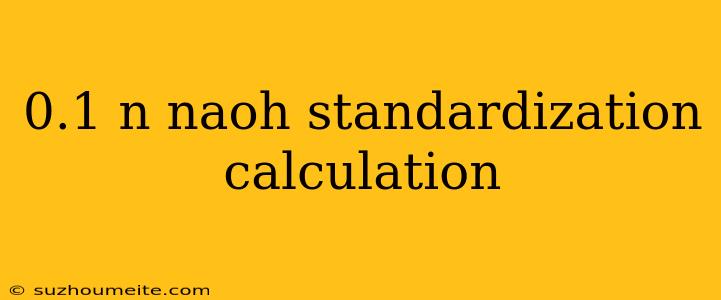0.1 N NaOH Standardization Calculation
Introduction
Sodium hydroxide (NaOH) is a strong base widely used in various industries, such as soap manufacturing, paper bleaching, and water treatment. In analytical chemistry, NaOH is used as a standard substance for titration reactions. The standardization of NaOH is crucial to ensure the accuracy of analytical results. In this article, we will discuss the calculation involved in the standardization of 0.1 N NaOH.
Principle of Standardization
The standardization of NaOH involves the reaction between NaOH and a primary standard acid, such as potassium hydrogen phthalate (KHP). The reaction is as follows:
NaOH (aq) + KHP (s) → NaKP (aq) + H2O (l)
The mole ratio of NaOH to KHP is 1:1, making it an ideal reaction for standardization.
Apparatus and Reagents
- 0.1 N NaOH solution
- Potassium hydrogen phthalate (KHP) crystals
- Distilled water
- Burette
- Conical flask
- Phenolphthalein indicator
Procedure
- Weigh accurately about 0.5-1.0 g of KHP crystals into a conical flask.
- Add about 50 mL of distilled water to the flask and stir until the KHP is completely dissolved.
- Add a few drops of phenolphthalein indicator to the solution.
- Titrate the KHP solution with 0.1 N NaOH solution until the color of the solution changes from colorless to pink.
- Record the volume of NaOH solution used for the titration.
Calculation
Let's assume that the volume of NaOH solution used for the titration is 25.00 mL.
The mole ratio of NaOH to KHP is 1:1, so the number of moles of KHP reacted is equal to the number of moles of NaOH reacted.
The molar mass of KHP is 204.22 g/mol, so the weight of KHP used is:
Weight of KHP = 0.5 g (example)
The number of moles of KHP is:
n(KHP) = Weight of KHP / Molar mass of KHP = 0.5 g / 204.22 g/mol = 0.00245 mol
Since the mole ratio of NaOH to KHP is 1:1, the number of moles of NaOH reacted is also 0.00245 mol.
The concentration of NaOH solution can be calculated using the following formula:
Concentration of NaOH = Number of moles of NaOH / Volume of NaOH solution = 0.00245 mol / 0.02500 L = 0.098 mol/L
Since the desired concentration of NaOH solution is 0.1 N, the factor of normality can be calculated as follows:
Factor of normality = Desired concentration / Calculated concentration = 0.1 N / 0.098 mol/L = 1.02
The 0.1 N NaOH solution can be standardized by multiplying the volume of the solution by the factor of normality.
Conclusion
In this article, we have discussed the calculation involved in the standardization of 0.1 N NaOH solution using potassium hydrogen phthalate as a primary standard acid. The standardization of NaOH is crucial to ensure the accuracy of analytical results. By following the procedure and calculation outlined in this article, you can accurately standardize your 0.1 N NaOH solution.
